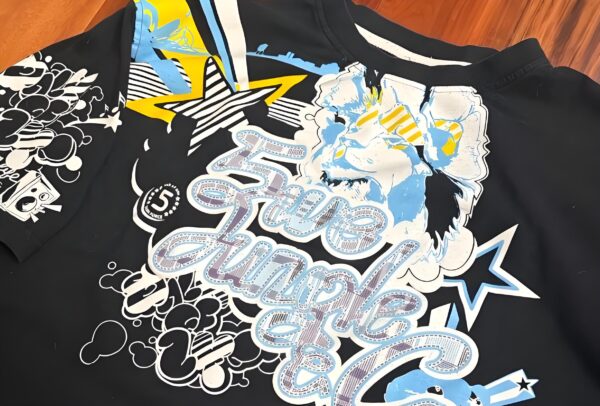Conclusion
Choosing between plastisol vs water based ink ultimately depends on your specific needs and preferences. Plastisol ink is known for its vibrant colors, durability, and ease of use, making it an excellent choice for bold, long-lasting prints. In contrast, water-based inks offer a softer, more breathable finish that is eco-friendly and ideal for high-end apparel.
By understanding the characteristics of both screen printing ink plastisol and water-based ink, you can make an informed decision on which ink type will best suit your next screen printing project. Whether you prioritize vibrancy, durability, softness, or environmental impact, there’s an ink solution that will meet your requirements.
Which Ink is the Best? Comparing Plastisol vs Water Based Ink
When it comes to screen printing, choosing the right ink is crucial for achieving the desired results. Two of the most popular types of inks used in screen printing are plastisol ink and water-based ink. Each has its unique properties, advantages, and drawbacks, which can significantly impact the outcome of your printing projects. In this article, we’ll dive into the details of plastisol vs water based ink, comparing their characteristics to help you determine which one is best suited for your needs.

What is Plastisol Ink?
Plastisol ink is a PVC-based ink that has been a staple in screen printing for decades. Known for its vibrant colors and versatility, plastisol screen printing ink is widely used for printing on a variety of fabrics, particularly cotton and polyester. This ink does not dry unless exposed to heat, making it easier to work with during the printing process.
Screen printing ink plastisol creates a layer of ink that sits on top of the fabric, offering a bold and opaque finish. This quality makes it an excellent choice for designs that require bright and vivid colors. Additionally, plastisol print has a high level of durability, withstanding multiple washes without fading or cracking.
What is Water Based Ink?
Water-based inks, on the other hand, use water as the primary solvent, making them more eco-friendly compared to plastisol inks. These inks penetrate the fabric fibers, resulting in a softer, more natural feel on the garment. Water-based inks are often favored for their breathable finish, making them ideal for lightweight and high-quality apparel where comfort is a priority.
Unlike screen printing ink plastisol, water-based inks dry through evaporation, so they require a more controlled printing environment. Proper curing is essential to ensure the ink sets correctly and achieves the desired durability.
Plastisol vs Water-Based Ink: Key Differences
To better understand the distinctions between plastisol vs water based ink, let’s break down their key differences in terms of application, finish, durability, and environmental impact.
1. Application Process
- Plastisol Ink: One of the main advantages of plastisol screen printing ink is its ease of use. Since it doesn’t dry unless heated, plastisol ink allows for longer working times, making it ideal for complex designs or multi-color prints. Ink for screen printing with plastisol can be left on the screen without the risk of drying, allowing for more flexibility during the printing process.
- Water-Based Ink: Water-based inks require a more controlled environment, as they dry quickly through evaporation. This means screens can clog if the ink is left sitting for too long. Printers using water-based inks need to work efficiently and keep screens hydrated to prevent drying issues. However, the thin consistency of water-based ink makes it easier to achieve fine details in prints.
2. Finish and Feel
- Plastisol Ink: Plastisol inks are known for their vibrant and opaque finish. The ink sits on top of the fabric, creating a slightly raised texture that is particularly effective for bold designs. While this finish is durable, it can feel somewhat heavier on the garment, which may not be ideal for all applications.
- Water-Based Ink: Water-based inks soak into the fabric fibers, resulting in a softer, more breathable finish. This is often preferred for printing on lightweight garments, such as t-shirts and sportswear, where a soft hand feel is desirable. The ink’s absorption into the fabric gives it a more subtle, vintage look compared to the boldness of plastisol print.
3. Durability
- Plastisol Ink: When it comes to durability, plastisol screen printing ink is hard to beat. Once cured properly, plastisol print can withstand countless washes without cracking, peeling, or fading. This makes it a top choice for garments that require high durability, such as workwear or athletic uniforms.
- Water-Based Ink: Water-based inks also offer good durability, especially when properly cured. However, because the ink becomes part of the fabric rather than sitting on top of it, it may not be as resistant to fading as screen printing ink plastisol over time. That said, water-based inks are less prone to cracking since they penetrate the fabric fibers.
4. Curing Process
- Plastisol Ink: Plastisol inks require heat curing to bond with the fabric. Typically, this involves heating the ink to around 320°F (160°C) to ensure it adheres properly. The curing process is straightforward, and the ink remains in a liquid state until it is heated, allowing for easier handling during the printing process.
- Water-Based Ink: Water-based inks cure through evaporation, so they require both heat and airflow to set correctly. This process can be more time-consuming and requires a controlled environment to avoid issues like smudging or bleeding. Additionally, water-based inks may require a longer curing time compared to plastisol ink.
5. Environmental Impact
- Plastisol Ink: One of the main drawbacks of plastisol inks is that they are not as environmentally friendly due to their PVC base and the need for chemical solvents in cleaning. However, some modern plastisol formulations are phthalate-free and aim to reduce environmental impact.
- Water-Based Ink: Water-based inks are considered more eco-friendly since they use water as a solvent and do not contain PVC or phthalates. Clean-up is easier and can often be done with water, reducing the need for harsh chemicals.
Advantages of Plastisol Ink

- Vibrant Colors: Plastisol screen printing ink offers bright, bold colors that are highly opaque, making them ideal for printing on dark fabrics.
- Ease of Use: Plastisol inks remain in a workable state until heated, providing flexibility during the printing process.
- Durability: Plastisol prints are known for their long-lasting finish that withstands repeated washings without losing quality.
Advantages of Water-Based Ink
- Soft Feel: Water-based inks create a soft, breathable finish that integrates with the fabric, making it comfortable to wear.
- Eco-Friendly: Being water-based, these inks are less harmful to the environment and require less chemical use during clean-up.
- Detailed Prints: The thin consistency of water-based ink allows for detailed and intricate designs.
When to Use Plastisol Ink
Plastisol ink is the preferred choice when printing bold, opaque designs, especially on dark garments. It is also the go-to option for projects that require high durability, such as athletic gear or promotional items that will undergo frequent washing. Additionally, plastisol screen printing ink is ideal for novice screen printers due to its forgiving nature and ease of use.
When to Use Water-Based Ink
Water-based inks are best suited for projects that prioritize a soft hand feel and eco-friendliness. They work well on light-colored fabrics and are often used for high-end apparel, fashion items, and designs where a softer, more natural look is desired. Water-based inks are also an excellent choice for intricate and detailed prints, as their thin consistency allows for precision.
Combining Plastisol and Water-Based Inks
While plastisol vs water based ink often presents a choice between one or the other, it’s also possible to use both in a single project. For example, you can use water-based ink for the base of a design to achieve a soft feel and then add plastisol ink on top for highlights or raised effects. This approach allows you to harness the benefits of both ink types to create unique and varied textures in your prints.








